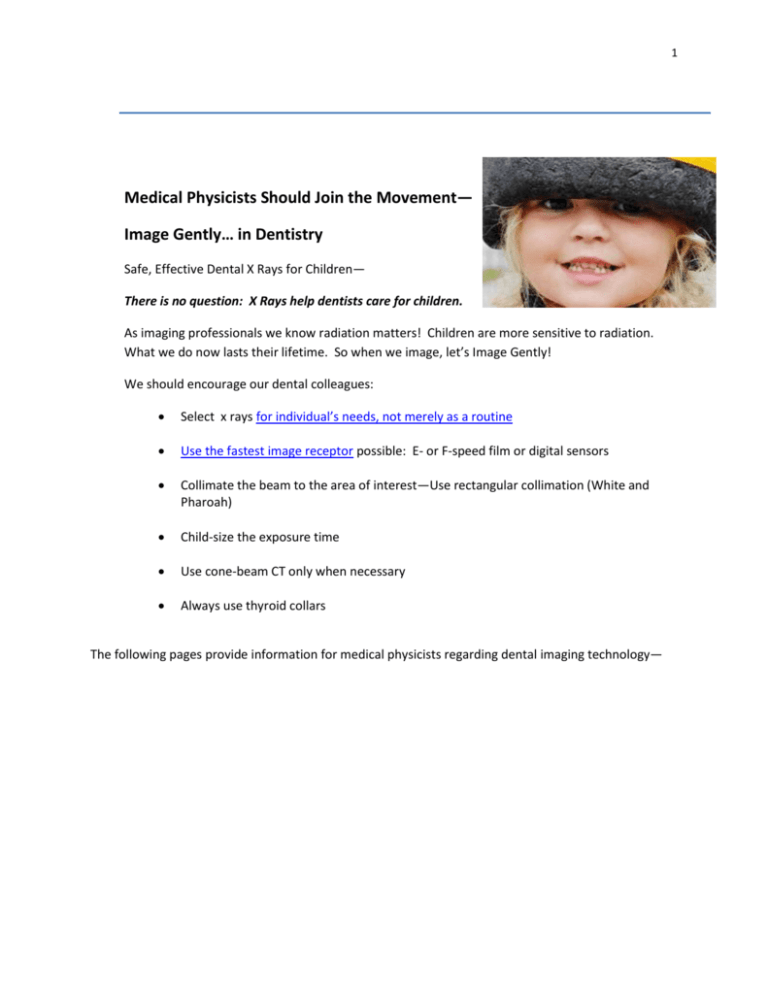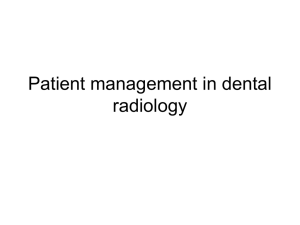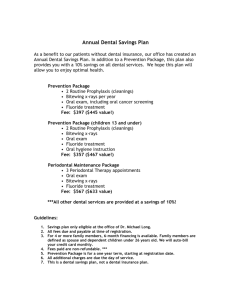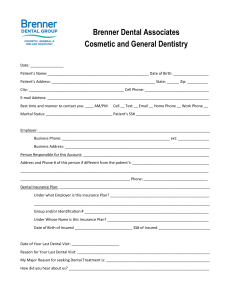What a medical physicist needs to know when
advertisement

1 Medical Physicists Should Join the Movement— Image Gently… in Dentistry Safe, Effective Dental X Rays for Children— There is no question: X Rays help dentists care for children. As imaging professionals we know radiation matters! Children are more sensitive to radiation. What we do now lasts their lifetime. So when we image, let’s Image Gently! We should encourage our dental colleagues: Select x rays for individual’s needs, not merely as a routine Use the fastest image receptor possible: E- or F-speed film or digital sensors Collimate the beam to the area of interest—Use rectangular collimation (White and Pharoah) Child-size the exposure time Use cone-beam CT only when necessary Always use thyroid collars The following pages provide information for medical physicists regarding dental imaging technology— 2 What a medical physicist needs to know when surveying a dental facility Many medical physicists are highly experienced with multiple advanced imaging modalities, such as mammography, multi-detector computer tomography (MDCT), interventional fluoroscopy, and other imaging modalities in medicine. But providing medical physics services to a dental office requires attention to a different set of issues. This document reviews the major areas of focus for a medical physics survey of a dental office, and addresses relevant image quality and radiation safety principles. 1. The effective doses are so low, why do we worry about dental offices? a. Remember that many dental patients are children and some offices image asymptomatic patients. Image Gently is committed to helping professionals provide the necessary imaging at the lowest radiation dose consistent with meeting those clinical imaging objectives. The medical physicist is the ideal professional to guide the dental practitioner to methods of reducing dose while providing essential image quality. Effective doses are low but skin doses for intraoral radiography are relatively high due to the use of direct x-ray film exposure, i.e., no intensifying screens. A full mouth survey may include up to 20 radiographs, each at approximately 200 mrad each resulting in a skin dose on the order of a CT scan, although to a smaller volume. 3 What a medical physicist needs to know when surveying a dental facility 2. To refresh your memory, here are the most common types of dental images produced: a. Bitewing images of the chewing surfaces of the teeth with the patient biting down, and typically show four teeth: two maxillary (upper) and two lower (mandibular). These images can be acquired using either small dental film packets or a reusable digital image receptor. (White, 2009) There are two types of digital receptors—computed radiographic (CR) plates and direct digital radiography (DR). b. Full Mouth Series consists of 16 to 20 films, taken to show all teeth. The actual number of films required varies slightly depending on practitioner preference and the number and size of the teeth in the patient’s mouth. The same equipment used for bitewings is used for all the images in a full mouth series. c. Cephalometric images are full size radiographs of the skull, typically 8x10-inch, taken either AP or Lateral. Film images are taken in an 8x10-inch cassette with a phosphorescent screen. Digital images are acquired with a digital image receptor, not unlike those used in general radiography. 4 What a medical physicist needs to know when surveying a dental facility d. Panoramic radiographs use an aperture that allows a thin slit of radiation to expose the patient and image receptor as the x-ray tube and image receptor rotate around the patient, with the image receptor translating at the same time. (White, 2009) Panoramic images are used to show the relationship between all teeth and the relevant bones. These images are acquired with a special sized sheet of dental film (15x30 cm or 5x12 inches), placed in a flexible light tight cassette, designed to provide intimate contact with the phosphorescent screen. Digital dental panoramic units may use a slot digital image receptor. 5 What a medical physicist needs to know when surveying a dental facility e. Cone beam CT (CBCT) has become increasingly popular in dental specialty offices and is now appearing in general dentistry practices. CBCT systems appear visually similar to panoramic x-ray units, but instead of a slit aperture, the beam is collimated to the 8x10-inch digital image receptor. The CBCT images provide excellent image quality and are being utilized for an increasing number of diagnostic purposes in dentistry. The effective dose may be an order of magnitude higher than from a bitewing, primarily because more organs are exposed. Combined panoramic-CBCT systems have been introduced that utilize a slot shaped image receptors for panoramic imaging and a 2D digital image receptor for CBCT. Some systems have become available with multiple-use selectable collimation that allow the user to reduce the field to the area of interest, but with an associated potential for operator error. Large Volume CBCT Images 6 What a medical physicist needs to know when surveying a dental facility CBCT Images Small Volume CBCT Large Volume CBCT: Three-dimensional on left; Coronal on right 7 What a medical physicist needs to know when surveying a dental facility 3. First, evaluate the image receptor and dose. a. If the facility is using dental film, check to see that they are using E-speed film, F-speed film , or what is referred to as “E- F speed” film. This may require some detective work, if the film is purchased by mail in bulk. While many facilities have converted to digital image receptors, recent data shows that 31% to 64% continue to use D speed film. (Gray, personal communication; also Table 1) The image quality for E-, F-, and E-F-speed films is similar to that obtained with D-speed film (Bernstein, 2003; FDA, 2014; Ludlow, 2001; Syriopoulos, 2001) at approximately one-half of the radiation dose. (Table 1) More information on the different speed films and image quality can be found here. This table also provides some other insights. The average exposure for D-speed film is about 260 mR. This is much higher the necessary. D-speed film exposures should be on the order of 175 to 225 mR. (Table 2) In other words, there is no need for dental exposures in excess of 225 mR for D-speed film. For histograms showing the wide range of bitewing exposures in use today see Pages 5 and 6 of this PowerPoint presentation. Table 1 Dental Bitewing X-Ray Exposures (mR) (Courtesy New York State Department of Health) Dental Bitewing for 2009 (N=7,205) Type D E F Digital Total 3,483 1,001 774 1,947 % of Total 55% 16% 12% 31% Average 256 162 148 105 SD 99 72 63 59 Highest 2,150 1,320 520 693 Average 258 162 140 106 SD 93 70 67 58 Highest 860 786 952 712 Average 262 161 148 110 SD 106 68 58 64 Highest 3,308 675 650 560 Dental Bitewing for 2005 (N=6,325) Type D E F Digital Total 3,084 1,118 500 1,623 % of Total 49% 18% 8% 26% Dental Bitewing for 2001 (N=8,600) Type D E F Digital Total 5,127 1,674 510 1,289 % of Total 81% 26% 8% 20% 8 What a medical physicist needs to know when surveying a dental facility Table 1 also provides insight relative to radiation exposure over time. As can be seen the exposures from 2001 to 2009 remain virtually unchanged, although these exposures all could be much lower. This indicates that there is a significant amount of work to be done on educating the practitioners about radiation exposure, and how to optimize image quality and radiation dose. Table 2 provides suggested exposure ranges for dental bitewing x-ray exposures. As can be seen, the average exposures in Table 1 typically exceeds the suggest exposure ranges in Table 2. For film imaging, this is usually caused by under-processing film due to depleted chemicals. More information can be found here. Table 2 Suggested Dental Bitewing Exposure Ranges D Suggested Exposure Range (mR) 175 to 225 E-F or F 100 to 125 Digital-CR 60 to 120* Digital-DR CMOS 50 to 100* Digital-DR CCD 40 to 60* Type *Based on 25th and 75th percentile of optimal exposure from Table II from Udupa, H., et al., Oral Surg Oral Med Oral Pathol Oral Radiol 2013;116:774-783. Note—Required exposure for optimal image quality varies with digital sensor type. Table 2 should be considered as a starting point for image quality and dose optimization. b. Using the posted technique chart, measure and evaluate the dose. Compare with references. (NCRP, 2003; NCRP 2012) Ask the staff open ended questions like “What techniques do you use for bitewings? Do you have different techniques for children?” If you choose to make alternate technique recommendations, provide a written technique chart for each unit, for adult and pediatric patients. For facilities with multiple x-ray units of different manufacturers or models, it may be beneficial to provide an additional single technique chart showing the differences for all x-ray systems in the suite. 9 What a medical physicist needs to know when surveying a dental facility c. Digital image receptors require less radiation skin dose than film imaging. CR (photostimulable phosphor) receptors require a dose similar to E-, F-, or E-F-speed film. DR image receptors can provide clinical images in the 40 to 100 mR range, dependent on the type of digital receptors. Image and radiation dose optimization should be carried out using the data in Table 2 as a starting point. (It is not uncommon to find significantly higher doses being delivered for digital imaging.) d. Digital imaging has eliminated the need for film processing and all of the associated issues. However, there are issues associated with digital imaging which should be investigated during an evaluation. The medical physicist’s experience with digital imaging in general radiography, dose creep, and challenges associated with the conversion to digital imaging will be fully applicable here. For more information click here. 4. Radiographic film processing conditions and quality vary considerably in the dental imaging community. Verify that proper time-temperature developing is being used. Film processing tips are included in Link B. Film processing is usually the weakest link in the imaging chain, with underprocessing resulting in low contrast radiographs and increased patient doses. The histograms on Pages 5 and 6 in this PowerPoint presentation clearly demonstrate the broad range of patient doses and suboptimal photographic processing (approximately one-third of the facilities produce films with inferior contrast) in use today. To assist with testing processing conditions, inexpensive devices are available for dental film processing quality control. These are also helpful in assuring appropriate initial film exposure technique selection and processing conditions. 10 What a medical physicist needs to know when surveying a dental facility 5. Evaluate the x-ray generator and output using standard techniques. Be sure that your radiation detector is properly positioned, and sized appropriately to include the complete x-ray beam. Modern units typically operate at only a single kVp and mA. 6. Carefully evaluate beam collimation. For intraoral radiographic units, consider recommending a rectangular aperture, which has been shown to significantly reduce effective dose by providing an x-ray beam that more closely approximates the rectangular image receptor. (White and Pharoah) The diagnostic medical physicist’s experience with the benefits (image quality and radiation safety) derived from collimating the x-ray beam to the image receptor in body radiography and fluoroscopy (for example), will be directly applicable here. Evaluating collimation for panoramic or CBCT systems requires some pre-planning, and may be accomplished using GAF Chromic Film and the manufacturer’s specifications for geometry. The photo on the left shows self-developing x-ray film taped to the surface of the x-ray tube cover. The mages at the right show two strips, following exposure. 11 What a medical physicist needs to know when surveying a dental facility Rectangular beam collimation reduces patient radiation dose by 60%. The following two PowerPoint slides provide some excellent visuals to demonstrate this point: See Progress and Challenges in Diagnostic Imaging for Children. 12 What a medical physicist needs to know when surveying a dental facility 7. Radiation Safety should be evaluated based on integrated exposure measurements using a dosimeter, taken at various locations within and near the x-ray source. Inquire about workload with the staff, and verify by reviewing representative patient logs. These should be readily available on digital systems. Be sure to account for any effect of very short radiographic exposure times. It may be necessary to increase the mAs to obtain a reading on your survey instrument. Be aware that CBCT systems are often located where panoramic units were previously installed. However, the scattered radiation dose from CBCT is substantially higher than for panoramic units (about an order of magnitude), due to the significantly larger field of view exposed in CBCT systems. Calculate the exposure to persons in the vicinity of the x-ray source following the principles of NCRP Report 147 (NCRP, 2004). While exposures and workloads may remain consistent from year to year for intraoral x-ray units, increased utilization of CBCT systems in recent years make it essential for the medical physicist to evaluate personnel exposure during each annual survey. At the very least the medical physicist should recalculate estimated weekly exposures using initial area survey measurements and recent workload data. Results should be compared with requirements from the local jurisdiction. Pay particular attention to personnel who may be working within line of sight of a CBCT unit or in an adjacent room, and make appropriate recommendations to assure ALARA. 8. Occupational Dosimetry. While many dental offices are not required to use personnel dosimetry, potentially increased utilization in a digital and CBCT imaging environment may warrant a renewed assessment of occupational exposure with personnel dosimetry. The associated exposure reports are useful to many facilities as a risk mitigation method where many personnel are young females of child-bearing age. 13 What a medical physicist needs to know when surveying a dental facility 9. Hand-Held Dental X-Ray Units are being used in many offices. One x-ray unit can be used in more than one room. These units must be appropriately shielded by the manufacturer at the x-ray tube and with a leaded-acrylic disk at the front of the position indicating device (PID) to reduce backscatter. Several papers have been published on the safety and image quality of these systems. (Brooks, 2009; Gray, 2012; Phillips, 2012; Thatcher, 2013) 10. Remember that a medical physicist can contribute to the quality of care delivered by a dental facility and personnel safety by following established imaging physics principles for both traditional and newer digital imaging technology. By speaking with the dentist and staff and understanding how x-rays are used in each practice setting the medical physicist’s recommendations can impact a very large number of patients. Check out these dental imaging tip sheets for further helpful information— A. D- versus E-F- or F-Speed Dental Films B. Radiographic Film Processing Tips C. Digital Imaging Tip Sheet 14 What a medical physicist needs to know when surveying a dental facility General References and Suggested Reading NCRP (2003). National Council on Radiation Protection and Measurements. Radiation Protection in Dentistry, NCRP Report No. 145. National Council on Radiation Protection and Measurements, Bethesda, Maryland. NCRP (2004). National Council on Radiation Protection and Measurements. Structural shielding design for medical x-ray imaging facilities. NCRP Report No. 147. National Council on Radiation Protection and Measurements, Bethesda, Maryland. NCRP (2012). National Council on Radiation Protection and Measurements. Reference levels and achievable doses in medical and dental imaging: recommendations for the united states, NCRP Report No. 172. National Council on Radiation Protection and Measurements, Bethesda, Maryland. Medwedeff, FM, (1972). Knox, WH and Latimer, PH, A new device to reduce patient irradiation and improve dental film quality. Oral surg, 15:1079. White, S.C (2009), Pharoah, M.J. Oral Radiology, Principles and Interpretation, 6th edition. Moseby Inc. and Elsevier Inc., 2009. Hand-held Dental X-Ray Units Brooks, S.L. (2009). McMinn, W.E., Benavides, E. Clinical trial of the Nomad portable X-ray unit. Journal Of the Michigan Dental Association. Gray, J.E. (2012). Bailey, E., Ludlow, J.B. Dental staff doses for hand-held dental intraoral x-ray units, Health Phys. 102(2), 137-142. Phillips, B.J. (2012). Ludlow, J., Platin, E., Mauriello, S. Comparative dosimetry of Nomad® Pro Handheld and wall-mounted x-ray units. Diagnostic Sciences, University of North Carolina, Chapel Hill. Available from http://dissexpress.umi.com/dxweb/search.html, Dissertation Number 1557173. Thatcher, A. (2013). Operator exposure using portable dental x-ray devices, see Page 23 et seq., available here, (Author, Andrew Thatcher, Washington State Division of Environmental Health Office of Radiation Protection, 111 Israel Road SE, Olympia, WA 98501, Ph 360-236-3231, andrew.thatcher@doh.wa.gov). 15 What a medical physicist needs to know when surveying a dental facility Image Quality and Dose Reduction with F-Speed Film Bernstein, D.I. (2003), Clark, S.J., Scheetz, J.P., Farman, A.G., Rosenson, B. Perceived quality of radiographic images after rapid processing of D- and F-speed direct-exposure intraoral x-ray films. Oral Surg Oral Med Oral Pathol Oral Radiol Endod, 96:4;486-491. FDA (2014). Dental Radiography: Doses and Film Speed. http://www.fda.gov/RadiationEmittingProducts/RadiationSafety/NationwideEvaluationofX-RayTrendsNEXT/ucm116524.htm Ludlow, J.B. (2001). Abreu, M. Jr., Mol, A. Performance of a new F-speed film for caries detection. Dentomaxillofac Radiol.30(2):110-3. Syriopoulos K. (2001), Velders, X.L., Sanderink, G.C., van Der Stelt, P.F. Sensitometric and clinical evaluation of a new F-speed dental x-ray film. Dentomaxillofacial Radiology 30, 40 – 44. Acknowledgements We would to thank Alan Lurie, D.D.S., Ph.D. for the dental x-ray images.





